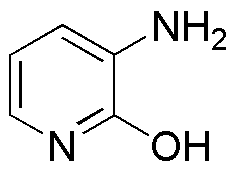3-Amino-2-hydroxypyridine is widely utilized in research focused on:
- Pharmaceutical Development: This compound serves as a key intermediate in the synthesis of various pharmaceuticals, particularly those targeting neurological disorders. Its unique structure allows for the modification of drug properties, enhancing efficacy and reducing side effects.
- Agricultural Chemicals: It is used in the formulation of agrochemicals, acting as a building block for herbicides and fungicides. This application helps improve crop yields and protect plants from diseases, contributing to sustainable agriculture.
- Material Science: The compound is explored for its potential in creating advanced materials, such as polymers and coatings. Its properties can enhance durability and resistance to environmental factors, making it valuable in construction and manufacturing.
- Biochemical Research: Researchers utilize it as a reagent in various biochemical assays, aiding in the study of enzyme activity and metabolic pathways. This application is crucial for understanding biological processes and developing new therapeutic strategies.
- Analytical Chemistry: It is employed in analytical methods for detecting and quantifying other compounds. Its ability to form stable complexes with metal ions makes it useful in environmental monitoring and quality control in various industries.
Informations générales
Propriétés
Sécurité et réglementation
Applications
3-Amino-2-hydroxypyridine is widely utilized in research focused on:
- Pharmaceutical Development: This compound serves as a key intermediate in the synthesis of various pharmaceuticals, particularly those targeting neurological disorders. Its unique structure allows for the modification of drug properties, enhancing efficacy and reducing side effects.
- Agricultural Chemicals: It is used in the formulation of agrochemicals, acting as a building block for herbicides and fungicides. This application helps improve crop yields and protect plants from diseases, contributing to sustainable agriculture.
- Material Science: The compound is explored for its potential in creating advanced materials, such as polymers and coatings. Its properties can enhance durability and resistance to environmental factors, making it valuable in construction and manufacturing.
- Biochemical Research: Researchers utilize it as a reagent in various biochemical assays, aiding in the study of enzyme activity and metabolic pathways. This application is crucial for understanding biological processes and developing new therapeutic strategies.
- Analytical Chemistry: It is employed in analytical methods for detecting and quantifying other compounds. Its ability to form stable complexes with metal ions makes it useful in environmental monitoring and quality control in various industries.
Documents
Fiches de données de sécurité (FDS)
La FDS fournit des informations de sécurité complètes sur la manipulation, le stockage et l’élimination du produit.
Spécifications du produit (PS)
Le PS fournit une description complète des propriétés du produit, notamment sa composition chimique, son état physique, sa pureté et les exigences de stockage. Il détaille également les plages de qualité acceptables et les applications prévues du produit.
Certificats d'analyse (COA)
Recherchez des certificats d'analyse (COA) en saisissant le numéro de lot du produit. Les numéros de lot et de lot se trouvent sur l'étiquette d'un produit, après les mots « Lot » ou « Lot de fabrication ».
Numéro de catalogue
Numéro de lot/série
Certificats d'origine (COO)
Ce certificat d'exploitation confirme le pays dans lequel le produit a été fabriqué, et détaille également les matériaux et composants utilisés et s'il est issu de sources naturelles, synthétiques ou autres sources spécifiques. Ce certificat peut être requis pour les douanes, le commerce et la conformité réglementaire.
Numéro de catalogue
Numéro de lot/série
Fiches de données de sécurité (FDS)
La FDS fournit des informations de sécurité complètes sur la manipulation, le stockage et l’élimination du produit.
DownloadSpécifications du produit (PS)
Le PS fournit une description complète des propriétés du produit, notamment sa composition chimique, son état physique, sa pureté et les exigences de stockage. Il détaille également les plages de qualité acceptables et les applications prévues du produit.
DownloadCertificats d'analyse (COA)
Recherchez des certificats d'analyse (COA) en saisissant le numéro de lot du produit. Les numéros de lot et de lot se trouvent sur l'étiquette d'un produit, après les mots « Lot » ou « Lot de fabrication ».
Numéro de catalogue
Numéro de lot/série
Certificats d'origine (COO)
Ce certificat d'exploitation confirme le pays dans lequel le produit a été fabriqué, et détaille également les matériaux et composants utilisés et s'il est issu de sources naturelles, synthétiques ou autres sources spécifiques. Ce certificat peut être requis pour les douanes, le commerce et la conformité réglementaire.


